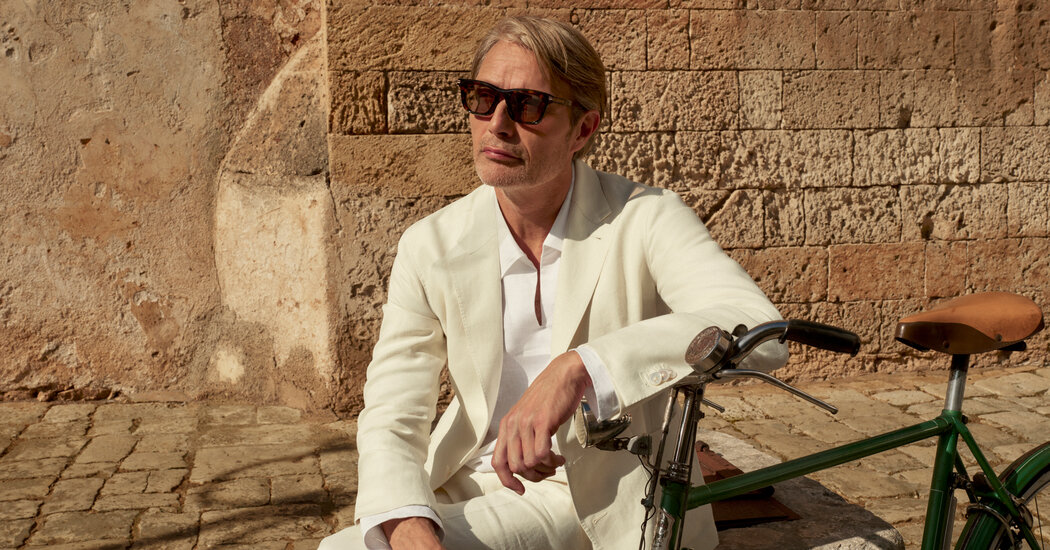Here is the plain text result:
In past eras, the wealthy tended to attire themselves in the richest of colors: indigo, crimson, the purple of nobilities and kings. We are no longer in that era. These days, the hue preferred by the richest people on earth is that most bland and mousy of non-colors — beige.
For Lindsey Woodcock, a luxury travel consultant, the beige onslaught first revealed itself on the terraces and streets of St. Moritz, Switzerland, the exclusive Alpine resort town where she lives part-time.
“It becomes something you can’t not see, said Ms. Woodcock, who also has residences in London and Sun Valley, Idaho. “There are flocks of people cruising around entirely in cream or beige or off-white.”
Against the backdrop of an anti-elitist mood in the United States and Europe, the privileged world of St. Moritz has become a place of soothing neutrals. You see it at shops like the cashmere purveyor Lamm, in the lobby of Badrutt’s Palace Hotel and on the terrace of the Paradiso restaurant, with its views of the Engadine Valley.
Why is this? The question was put to Alessandro Sartori, the artistic director of Ermenegildo Zegna, the Italian luxury goods label known for outfitting corporate titans and tech moguls. “The ultrawealthy don’t want to show off, and beige colors are good in that sense,” Mr. Sartori said by phone from Milan. “This class of people is super discreet and doesn’t want to be seen.”
To be fashionably superrich, he suggested, is to be clad in the anodyne colors of baby food, tea cookies or screen savers: latte, oatmeal, cream, butterscotch, café au lait.
“If bold hues once were a tell for wealth, now a preference for quiet colors has evolved into a “statement of luxury and power,” according to Filippo Ricci, the creative director of Stefano Ricci, a superluxury men’s wear purveyor in Florence, Italy.
“If you want a chair in crocodile that is like a throne, we can provide it,” Mr. Ricci said. Yet, even among the crocodile-throne set, he has noticed a shift. “My feeling is that color will eventually come back,” he said. “But right now, everybody likes beige.”
Certain members of the rarefied classes have adopted the related fashion strategy of dressing down. In particular, two social fixtures of St. Moritz — Rolf Sachs, an heir to several industrial fortunes and the proprietor of the exclusive Dracula Club, and his longtime companion, the German fashion designer and princess Mafalda of Hesse — favor what might be termed the zillionaire ragamuffin look.
Whether it includes the off-the-rack parkas and old jeans that the couple favor on the slopes, or the pale sable capes some wear while ordering truffle pizza on the deck of Langosteria restaurant, the muted style now in favor among the wealthy stands in stark contrast to historical preference.
During the Spanish colonial era, for instance, a carmine hue devised by the Aztec and Mayan people (and derived from an insect that feeds on prickly pear cactus) became a global commodity, as hotly traded as silver. Cochineal was the secret behind the saturated crimson of princely capes and cardinals’ robes. Color itself signaled wealth. Hoi polloi wore clothes in the hues of the vegetation or the animals they were made from.
The shift away from lush color as status marker is fairly recent, according to Caroline Rennolds Milbank, a fashion historian. “In the early 20th and 19th centuries, very rich people wouldn’t have wanted to wear something that was that practical,” Ms. Milbank said. “Beige was associated with work wear and the most pedestrian of utilitarian clothes.”
In keeping with the shift away from bright hues among the wealthy, the Pantone Color Institute has named “mocha mousse” its 2025 Color of the Year. In selecting this shade, the Pantone committee was inspired by the feelings it evoked of “comfort, indulgence and subtle elegance,” said Leatrice Eiseman, the institute’s executive director. “When we do color/word association, the creams, the taupes, the camels signify that something has longevity, lineage, is long lasting and secure,” she added.
As global markets are roiled, the richest of the rich hunker down in khaki camouflage. Beige tones, said Robert H. Frank, a retired professor of economics at Cornell University and the author of “Luxury Fever: Why Money Fails to Satisfy in an Era of Excess,” send a particular signal. “You don’t need to have bright, screaming colors to announce your presence,” he said. “You have assets aplenty in reserve. You don’t need to make a big noise.”
Ask that longtime proponent of the notice-nothing look, the billionaire Italian fashion magnate Brunello Cucinelli.
“Last week, I went skiing with my family, and all our ski gear was beige, brown, Panama,” Mr. Cucinelli said from his home in Solomeo, Italy. “I do not want to sound bigheaded, but when I first came out with these colors — a Panama corduroy suit, ecru jackets for winter — people thought, ‘Only the pope can wear these colors!’”
“I’m a little shy to say it,” he continued, “but I’m convinced that I took a little bit of a part in this change of colors.”
And if more and more wealthy people have suddenly decided to adopt those shades as an intrinsic part of their uniform, so much the wiser.
“Basically,” Mr. Cucinelli said, “that displays how smart they are.”
Source link




